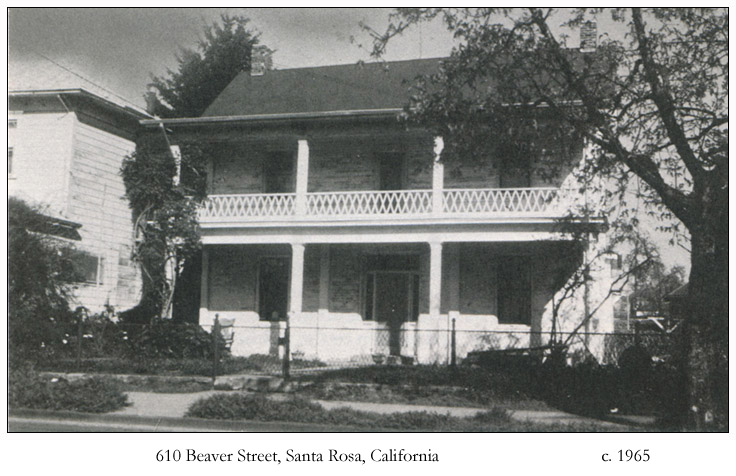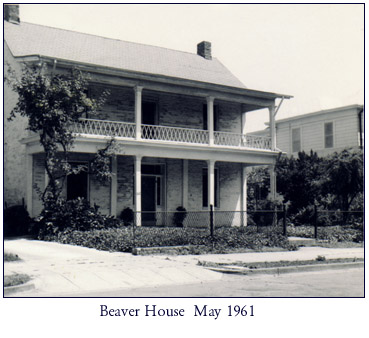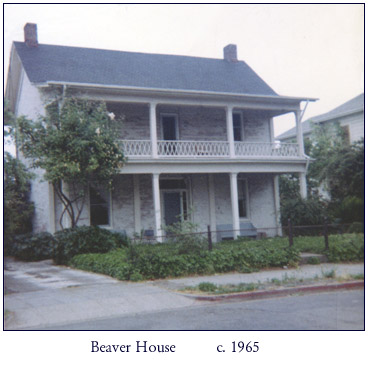
|
The last owner of this house was Jeanne Thurlow Miller, a Santa Rosa historian. From her Seeing Historic Sonoma Today (The Miller Associates, 1967): |
|
James A. Cockrill, his wife and daughter, settled in the Santa Rosa Valley on 160 acres which were purchased from Julio Carrillo, the Mexican grantee. After his death in 1852, his widow remained until she sold the property to her brother-in-law, Henry Beaver, who arrived in 1853 with his family and a large party of relatives. He built a Classic Revival brick house, making the bricks on the property, with two-story galleries on both east and west sides. Beaver lost the property to the mortgagee in 1861, and H. W. McGee became the owner. After the earthquake of 1862, the house was repaired and an old frame house built by Cockrill in 1851 was added to the east side of the brick house. By this time, the town had moved from Franklin, on the east to Santa Rosa, one-half mile southwest of the house. The original farm was bounded by the present streets of Mendocino, Spencer, North and a creek which defined the south border, the southeast corner being marked by an enormous oak tree located at Fifth and North Streets. The land was subdivided in 1871. The house has been fully rehabilitated since 1958, and is open to the public from time to time at the convenience of the owner.
|
|
Jeanne Miller spent many years researching and restoring Henry Beaver's former home at 610 Beaver Street, however the house was knocked off its foundation in the destructive Santa Rosa earthquake of October 1, 1969. The city condemned it soon after. Jeanne attempted to appeal the ruling but did not succeed in preventing her much-loved home from being torn down by the city for the good of public safety. Ironically, if this had occurred a few years later, after the wholesale destruction in the seventies of most Northern California towns in the name of urban renewal, every attempt would have then been made to save Henry's old home as a matter of historical preservation.
|
|
From a series of conversations which I had with Jeanne in 1996 about the house (Also see her essay Literary Industries): |
|
Well actually, the house was in two sections: the frame part was built by James Anderson Cockrill and was on the property... He lived there and of course he died before they [the rest of his family] ever got back, but then of course after eighteen fifty-three then Henry Beaver built a brick house -- made the bricks right on the property and built the house -- but they must of had an outside kitchen somewhere -- because it was just the two rooms down and two rooms up with a hall in-between. Then after he lost it in 1857, then in 1860... after the sheriff’s sale -- the McGee’s acquired it, and the strangest part -- the only way I found out about it was that I had... what I called the carriage house -- actually a little old garage... had been propped up. I had the Chris Brothers come and move it and put down in 1960, and when they came and brought me the bill and we were talking about it, because they had done a lot of work for my mother and I knew them like friends, and they said, You know it’s strange, we looked in our books today and the very first job that we did, when we went into business in 1860, was on this property. And then he said, This is the last job we are going to do, we’re going out of business! ..that's when [James A. Cockrill] lean-to [on the Franklin side of the property] was moved and attached on the back -- there was a slight misconnection there... a slope in one of the stairways and things like that which you could see that it was an after thought. But it made a good house -- it made a nice eight room house... all it needed was roof and a foundation and everything in-between, is the way I usually put it, because it was... plumbing, wiring, everything had to be done of course from fresh. When I got it [1958], it had been used... it had been rented out for twenty-five dollars a month and they had rented out apartments for fifteen dollars a month a piece. In fact, that’s how I happened to go there when I was about... twelve years old... and I knew the house from the outside and from having been in the parlor but never have seen any more of it. But I had to clean up the fireplaces and redo them and everything, so... my sons were horrified! That I should buy such a thing! ...and got started on the restoration, which I hadn’t even completed after ten years... [After the 1969 earthquake] I went to the City, I went to the County, I went to the State -- I went to everybody and tried to get that lot declared as a monument because it was unique, for it’s period... there was nothing like it. When I was twelve years old my mother took me there -- there wasn’t even electricity in the house at that time I don’t think because it was so dark. And she said, This is the only house in Santa Rosa worth preserving! And she thought that Victorians should be condemned too. Now they are bowing three times to the East every time they see a Victorian...
|
|
|
 |
 |
|
As Jeanne mentioned above, this style of house was uncommon for California. It is fairly obvious, that relatively small, two-fireplace, two-story brick home with a steep roof is somewhat impractical in California. However, she also told me that she saw similar houses in other locations where the Beavers lived in Missouri and Ohio. Henry's house, appears to have been a variation of a type of British folk house in the Tidewater South Tradition known as an "I-house." These were first built by the early English colonist of the coastal South and common in pre-railroad America. Building such houses with brick masonry rather than wooden planks was also established early. From A Field Guide to American Houses, by Virginia and Lee McAlester (Alfred A. Knopf: New York, 1991), p. 96: |
|
Similar forms occurred in the Midland area of log construction but were uncommon, probably because of the difficulty of constructing two-story walls made of sold, hewn logs. With the arrival of the railroads, however, I-houses again became a popular folk form over much of the eastern half of the country. They were particularly favored as modest folk dwellings in the midwestern states where the relatively long and confining winters made large houses more of a necessity than farther south. Post-railroad southern examples are also common, but these were usually the more pretentious houses of affluent local gentry. For this reason, many of these later southern I-houses have added stylistic detailing to make them appear fashionable. Like their hall-and-parlor relatives, post-railroad I-houses were elaborated with varying patterns of porches, chimneys, and rearward extensions.
|
|
When I first visited the Massanutten area of Virginia in 2004 in search of information about Henry's ancestors, I was surprised to see many of these I-houses, particularly in the Luray area. Many of them were of relatively recent construction. Certainly the steep roofs (often made of metal) made a lot of sense in the area were the snows can be quite heavy in the winter and the two fireplaces would be very handy in keeping both ends of the house warm. Of course, Henry's affectation of the Spanish-influenced second-story porch was missing from the Virginia homes, but the single A-frame roof, two story brick building, with two chimneys on both ends was a quite common sight throughout the area. Henry's cousin John Beaver, owned a brick I-house along the Shenandoah river in what had been Abraham Strickler's Egypt plantation. It was believed that the house was built by John's son, Daniel Beaver. From the images I was able to find of it, the resemblance of this house to Henry's was clearly apparent. Unfortunately though, I was not able to find the actual house to take a picture of it during my short visit there. Brick making and masonry work appears to have been a common skill among Beaver family members and it could bear more study here. Another example of such work can be found with Henry's supposed first cousin, once removed, Jacob Beaver. |
This page created on 04/06/01 11:46. Updated 12/31/05 17:55.